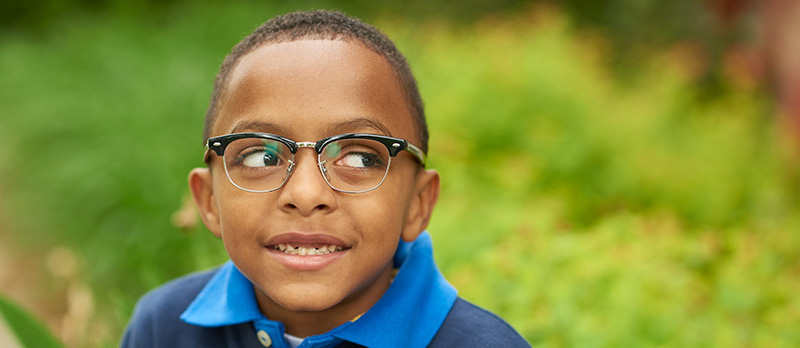Myopia, or nearsightedness, is one of the most common vision problems in childhood. In fact, about 9% of kids ages 5-17 are nearsighted. Kids with this condition can usually see things close up, but struggle to see things far away. It is often diagnosed around first or second grade when they struggle to see the board in class.
While a diagnosis of myopia might not sound serious, it’s important to treat it with corrective lenses (glasses or contact lenses) as soon as possible. Many parents are surprised when I explain that not doing so can put kids at risk for serious vision-related conditions later in life. Also, blurry vision can cause kids to struggle in school. It’s commonly thought that wearing corrective lenses will make your child’s eyes worse over time. This is not true! Myopia increases when your eyes grow. Wearing corrective lenses just makes it easier to see!
As an optometrist, it’s not only my role diagnose myopia, but to help families understand what they can do to help slow down the progression of the disease. After all, once kids are myopic, they will be myopic for the rest of their lives. Here are a few more things parents should know about the condition:
5 Things to Know About Myopia (Nearsightedness) in Kids:
1. It’s Growing in Prevalence
While we don’t know the exact reason why, the incidence of myopia has been increasing steadily. According to the National Eye Institute, approximately 42% of Americans ages 12-52 are nearsighted, which has increased from 25% since 1971. Genetics and environmental factors may play a role, however it doesn’t follow a specific pattern, even in the same family. For instance, we know that if both parents are myopic, their child is more likely to be, too. However, if those parents have two children, one can be myopic and one might not be.
2. How It Happens
Myopia most often happens when the eyeball grows too much lengthwise – from front to back. In a person with normal vision, light enters the eye and it focuses directly on the retina, which allows clear vision. In a myopic eye, light focuses in front of the retina and creates blurred vision. This is the reason why myopia never goes away – because there’s no way to make your eyeball shrink!
3. The Risk of Developing Other Eye Diseases
There is a strong association with higher amounts of myopia and the risk of certain eye diseases as your child gets older. This includes diseases like macular degeneration, retinal detachments, glaucoma and cataracts, which can all potentially cause blindness. In fact, once he or she goes beyond -4.00, risk for these conditions goes up about 10 times. So it’s important to take steps to try to prevent his or her eyes from getting worse over time.
4. How to Help Slow the Progression
Here are a few things that you can do at home to help slow the progression of myopia over time:
- Spend time outside each day. Research has shown that children who spend at least 90 minutes in natural sunlight each day have slower rates of myopia progression. We believe that being outside is helpful because they’re giving their eyes a break by looking at things further away. It also may be the brightness of the natural sunlight that helps, however not the UV light. So please wear hats, sunglasses, and sunscreen!
- Take regular breaks from close work every 30 minutes. This includes tablets, phones, books, and drawing. It doesn’t have to be an extended break, just long enough to allow your eyes to relax. Look out the window, walk down the hallway, or get up to get some water.
- Keep a good working distance. Holding things closer to your face causes your eyes to strain and work harder to see. The recommended distance is approximately the same length of your child’s forearm, or the distance from their elbow to knuckles.
- Utilize good lighting. Make sure your child utilizes good lighting when they’re reading or doing homework. This helps to prevent eye strain.
5. Other Treatment Options Available
There are other treatment options available to help slow the progression of myopia. Research has shown these treatments to be successful, however, the USDA has not approved these treatments specifically for myopia control. These treatments are used for other reasons and have shown no greater risk for using them for myopia management.
- Soft multifocal (bifocal) contact lenses. These contact lenses bend light in a specific way to help relax kids’ focusing systems. They are 30-50% effective, according to current research.
- Low dose Atropine eye drops. These drops help relax the focusing system, though the exact mechanism is unknown. They are 30-75% effective, according to current research.
- Orthokeratology contact lenses. These contacts are worn only at night during sleep and reshape the cornea so that glasses or contacts are not needed during the day. They are 30-100% effective, according to current research.
When To Seek Additional Help
If your child’s prescription is changing faster than you think it should, or if you’re worried about risk factors, bring it up to your child’s doctor. He or she may recommend a referral to a pediatric optometrist who can help you create a treatment and prevention plan.
To learn more about our ophthalmology department at Cincinnati Children’s, please call 513-636-4751 or fill out this online form for more information.

